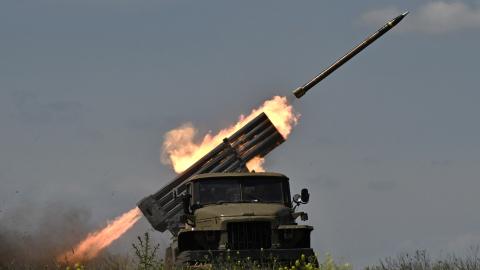This report first appeared as a part of Hudson's Re: Ukraine newsletter series. To subscribe, click here.
Below Hudson Senior Fellow Can Kasapoğlu offers a military situational report about the war in Ukraine.
1. Wagner Begins Training the Belarusian Military’s Elite Units
Open-source intelligence this week revealed that the Wagner Private Military Company has begun training elite units of the Belarusian Armed Forces in Belarus. Yevgeny Prigozhin’s fighters are now training the 38th Air Assault Brigade, which falls under the Belarusian Special Operations Command, and they may start training the 5th Spetsnaz Brigade and the 103rd Airborne Brigade later. Hudson Institute’s Ukraine Military Situation Report will continue to monitor open-source intelligence for signs that other Special Operations Command formations are cooperating with Wagner.
Social media uploads also showed Wagner fighters drilling alongside signals units of the Belarusian military’s 8th Radio-Technical Brigade, a unit subordinate to the Belarusian Air and Air Defense Command. This development suggests that Wagner is not merely training an amateur militia in Belarus but assisting that country’s military in developing advanced capabilities.
The latest commercially available satellite imagery reveals a large Wagner encampment on Belarusian territory hosting thousands of members of Prigozhin’s shadow army. Wagner’s rising ties with the Belarusian military flag a growing threat on NATO’s eastern front, potentially threatening Poland’s security. During his recent meeting with Vladimir Putin, Belarusian strongman Alexander Lukashenko even joked about Wagner fighters’ desire to move west and start a showdown with the Poles.
The composition of Prigozhin’s combat formations also concerns Western observers. Trucks carrying the insignia of Ukraine's breakaway Luhansk and Donetsk regions were spotted this week in Wagner columns. It is now likely that Wagner is sending fighters from Ukraine’s separatist paramilitaries into Belarus.
2. Russia Attacks Ukraine’s Population Centers, Shipping Infrastructure
Following Putin’s remarks last week announcing Russia’s withdrawal from the Ukrainian grain deal, the Russian military is now terrorizing the Black Sea coastal city of Odesa. Russia’s Black Sea Fleet and Aerospace Forces have joined with ground-based units in the Southern Military District to destroy commercial, maritime, and civilian targets.
The Ukrainian Ministry of Defense reported that Russian attacks have featured a dangerous combination of anti-ship missiles in land-attack roles (specifically the Onyx and Kh-22), Kalibr sea-launched cruise missiles, Iskander ballistic missiles, and Shahed-131 and Shahed-136 loitering munitions manufactured by Iran.
These Russian mixed-strike packages are damaging for several reasons. Most fundamentally, they are sustainable. Iran’s ability to sustain high levels of munitions production in support of the Russian campaign has given a boost to Putin’s flagging forces. With a Russo-Iranian joint production plant in Tatarstan soon coming online, the tempo of Russia’s drone salvos is unlikely to slow.
Mixed-strike packages also stress Ukrainian air defenses, which they are designed to penetrate. Cruise missiles, modified anti-ship and air-defense missiles, and loitering munitions possess drastically different trajectories and flight dynamics. This makes it difficult for the Ukrainian military to intercept incoming salvos. The danger of these strikes is amplified by their high-value target sets. British intelligence reports that recent Russian attacks have been directed at Ukraine’s port infrastructure.
It remains to be seen if Turkish diplomatic efforts will lead Russia to reconsider its decision to abandon the grain deal. Should these efforts fail, Russia’s bombardment of the infrastructure that Ukraine needs to ship its grain may unleash a new food crisis for the developing nations of the Middle East and Africa.
3. Battlefield Update: The Front Remains Stable in the South, Russia Probes in the East
Ukraine’s counteroffensive is making incremental gains in the south, with no breakthrough imminent. The conflict continues to prove positional and highly attritional, dominated by infantry, artillery, minefields, trenches, and engineering units. Large-scale combined arms maneuver warfare remains a minor component of the fight. Ukrainian M-SHORAD (maneuver short-range air defense) capabilities, which remain vital to the survivability of mechanized formations in the face of Russian air power, remain limited. The Ukrainian Armed Forces are also keeping some of their new Western-trained combat formations away from the action in the hope that they can be used later in a more favorable setting.
As a previous edition of this report anticipated, the Armed Forces of the Russian Federation have intensified offensive actions along the Kupyansk axis. On this front, Russia is seeking to push Ukrainian lines of defense back beyond the Oskil River to undo the successes of Ukraine’s 2022 Kharkiv offensive. Securing the Oskil River as a natural buffer would cement Russia’s occupation of Luhansk and mark a major achievement for the Kremlin.
Russia’s ongoing push is revolving around probing assaults, and at present has sustained no major breakthroughs. News stories suggest that Ukraine may be using American-transferred cluster artillery munitions to halt Russian advances.














